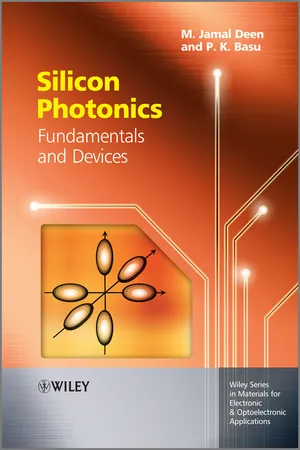Bragg's Law
Bragg's Law is a fundamental principle in the study of crystallography. It describes the relationship between the angles at which X-rays are diffracted by a crystal lattice and the spacing of the lattice planes. The law is expressed mathematically as nλ = 2d sin(θ), where n is an integer, λ is the wavelength of the X-rays, d is the spacing between lattice planes, and θ is the angle of incidence.
7 Key excerpts on "Bragg's Law"
- eBook - ePub
- Shailaja Mahamuni, Deepti Sidhaye, Sulabha Kulkarni(Authors)
- 2020(Publication Date)
- CRC Press(Publisher)
...Bragg and W.H. Bragg (father and son) and is known as Bragg’s law. A very simple geometrical diffraction condition was proposed by Braggs in 1912, immediately after Max von Laue observed (discussed earlier) the diffraction of copper sulphate single crystal. Braggs considered a set of parallel planes as illustrated in Fig. 6.3. Fig. 6.2: Elastic scattering of X-rays (Thompson scattering). Fig. 6.3: Bragg’s law. If the distance between the planes is d and angle of incidence (glancing or grazing angle) of X-rays with the planes is θ then the path difference between incident and reflected rays is 2 d sin θ. In order to have the constructive interference between any two rays, the path difference should be nλ. Therefore, the Bragg diffraction condition is written as n λ = 2 d sin θ (6.7) where n is the order of diffraction (n = 1, 2,...; usually n is taken as 1 because the intensity in higher orders is usually negligible), λ is wavelength of X-rays used, d is interplanar spacing and θ is the grazing angle that the beam makes with the set of parallel planes on which the beam is incident. It should be noted that d the distance between two planes in a crystal in fact represents the distance between any two consecutive planes in a set of infinite parallel planes in a crystal and is often denoted as d hkl where (hkl) denotes the Miller indices of the set of planes (see Box 6.1, Ewald construction). Diffraction is a result of constructive interference between the incident and scattered waves. Atoms (or ions) in the solid scatter the rays in all directions but only those which interfere constructively are able to produce diffraction. The angle 2θ is known as ‘angle of diffraction’ or ‘scattering angle’. It is also expressed in terms of wave vector transfer q. q = 4 π sinθ λ (6.8) Every diffraction pattern is a representation of different sets of planes in a crystalline solid...
- eBook - ePub
X-Ray Diffraction for Materials Research
From Fundamentals to Applications
- Myeongkyu Lee(Author)
- 2017(Publication Date)
- Apple Academic Press(Publisher)
...Bragg expressed the condition for X-ray diffraction in a much simpler mathematical form than that explained by von Laue. They found that some crystals, at certain wavelengths and incident angles, produced intense peaks of reflected X-rays known as Bragg peaks. W. L. Bragg explained this result by modeling the crystal as a set of discrete parallel planes separated by a constant parameter. It was proposed that the incident X-rays would produce a Bragg peak if their reflections off the various planes interfered constructively. The interference is constructive when the phase difference is a multiple of 2 π ; this condition can be expressed by Bragg’s law. In the following year, W. L. Bragg revealed the structures of NaCl, KCl, KBr, and KI, which all have the NaCl structure. This was the first to completely analyze the structure of crystalline material. W. L. Bragg and W. H. Bragg were awarded the Nobel Prize in physics in 1915 for their pioneering work in determining crystal structures. They are the only father-son team to jointly win the prize. W. L. Bragg was then 25 years old, the youngest Nobel laureate. Although it is very simple, Bragg’s law confirmed the existence of real particles at the atomic scale, as well as providing a powerful tool for examining crystals. The early work by Bragg had an immeasurable impact on the development of X-ray diffraction and modern diffractive optics. It is not surprising that Eq. (3.6), which dictates the period of two-beam interference pattern, is the same as the Bragg law for X-ray diffraction. 4.2 BRAGG LAW Let’s suppose that an X-ray beam of plane wave is incident into a crystal with atoms arranged on a set of parallel planes and the incident beam makes an angle of θ with the crystal plane, as shown in Figure 4.1. While the X-ray beam is scattered in all directions, we here consider the case where scattering occurs at an angle of θ with respect to the plane...
- eBook - ePub
- Alexander McPherson(Author)
- 2011(Publication Date)
- Wiley-Blackwell(Publisher)
...In Figure 5.6, d hk is the interplanar spacing for the hk family of planes, which we can calculate for any crystal from the unit cell parameters (see Table 3.2 of Chapter 3). From Euclid’s geometry we also know that the angles opposite d 1 and d 2 are both also equal to θ. Trigonometry then tells us that d 1 = d 2 = d hk sin θ. To obtain constructive interference, we already noted that d 1 plus d 2 must equal nλ ; hence This is the familiar formulation of Bragg’s law for a three-dimensional point lattice. It says that the Fourier transform of a point lattice is absolutely discrete and periodic in diffraction space, and that we can predict when a nonzero diffraction intensity will appear for any family of planes hk, and what the angle of incidence and reflection θ must be in order for an intensity to appear. Bragg’s law, notice, is completely independent of atoms, or molecules, or unit cell contents. The law is imposed by the periodicity of the crystal lattice, and it strictly governs where we may observe any nonzero intensity in diffraction space. It tells us when the resultant waves produced by the scattering of all of the atoms in the many individual unit cells, each represented by a single lattice point, are exactly in phase. Bragg’s law is essentially a three-dimensional case of the Dirac delta function, seen in Chapter 4, in that it specifies the diffracted radiation to be identically zero except for a discrete set of angular relationships between two variables and 0, or more precisely, for specific values of their difference,. Cast in terms of vectors, where is the plane normal and has length equal to λ / d hk the diffracted ray may be written as where N is the number of planes in the family, a very large number. Bragg’s law tells us something more. For the families of planes in Figure 5.6, – 0, the diffraction vector, is perpendicular to the family of planes as illustrated in Figure 5.7...
- eBook - ePub
- Richard J. D. Tilley(Author)
- 2019(Publication Date)
- Wiley(Publisher)
...The separation of atoms in crystals is similar to the wavelength of X-rays, and X-ray diffraction from crystals has been used for the elucidation of crystal structures since the early years of the twentieth century. Electrons or neutrons can also be diffracted by crystals and both these techniques are similarly widely used in structure analysis (Figure 6.14). Analysis of the diffraction patterns, as well as the intensity of the individual diffraction maxima (usually called reflections) gives exact information about the atom positions throughout the structure. The question of whether, for any angle of incidence, a strong diffracted beam will arise, is given by the Bragg equation (6.4) where d is the separation of the planes of atoms that are responsible for the diffraction, λ is the X-ray wavelength, m is the order of the diffracted beam, and θ B the Bragg angle between the X-ray beam and the atom planes (Figure 6.15). (Note here – the traditional angle of incidence used in optics, θ i, is the complement of the Bragg angle, θ B). Two beams (1 and 2 in Figure 6.15), diffracted (often referred to as reflected) from two adjacent planes of atoms spaced a distance d apart will interfere constructively and reinforce each other when the path difference between them is a whole number of wavelengths. This condition leads directly to Eq. 6.4. Figure 6.14 Electron diffraction pattern from a single crystal of the oxide WNb 12 O 33. The pattern is a plane section through the three-dimensional diffraction pattern Figure 6.15 The geometry of the diffraction of X-rays from a crystal lattice needed to derive Bragg's Law Crystals do not scatter X-rays very strongly. Only a very small proportion of the incident beam is diffracted and implicit in the Bragg equation is the notion that any X-ray photon is only scattered once...
- eBook - ePub
- Zhenan Bao, Jason Locklin, Zhenan Bao, Jason Locklin(Authors)
- 2018(Publication Date)
- CRC Press(Publisher)
...In addition, due to the low atomic number of the organic materials, the incident beam suffers a very small attenuation by absorption. In the general GIXD geometry, the angle of incidence of the x-ray beam is kept below the critical angle α c. This limits the penetration depth of the beam to that of the evanescent wave, and the scattering due to the subphase is efficiently eliminated. This permits a reliable measurement of the weak diffraction signal originating from the crystalline monolayer. When the substrate is disordered and thus scatters in all directions, the angle of incidence of the beam should be below the critical angle of the substrate in GIXD geometry. Conversely, if substrates are crystalline, as long as one stays away from the substrate Bragg peaks, no particular effort is needed to have the incident beam at less than the critical angle. Furthermore, this geometry increases the number of incident photons by ensuring that the whole thin film participates in the diffracted signal. From the GIXD profiles, the in-plane lattice parameters can be derived simply by using the Bragg’s law. Figure 4.1.1 shows schematic representation of grazing incidence diffraction from a horizontal surface. The diffraction condition for two-dimensional crystals lying in the xy plane is that the component of the scattering vector in the horizontal plane, labeled q xy (q xy = q ∥ ≈ (4π/λ)sinθ hor (where 2θ hor is the in-plane angle between the incident and the diffracted beam), must coincide with a reciprocal lattice vector q hk = 2π(h a * + k b *), where a * and b * are the reciprocal in-plane lattice vectors and h and k are the linear coefficients for the corresponding lattice point. There is no similar selection rule or restriction on the component of the scattering vector along the normal to the film defined as q z, whose magnitude q z = q ⊥ = (2π/λ)sinα, where α is the angle between the diffracted beam and the substrate surface, shown in Figure 4.1.1...
- Douglas B. Murphy, Michael W. Davidson(Authors)
- 2012(Publication Date)
- Wiley-Blackwell(Publisher)
...5.2 b). The spreading of an automobile’s headlight beams on a foggy night is another good example of the phenomenon. In these cases, diffraction is defined as the scattering of light by small particles having physical dimensions similar to the wavelength of light. The amount of scattering and angle of spreading of the beam depend on the size and density of the light-diffracting particles. In the case of illuminated specimens in the microscope, there are therefore two primary sites of diffraction: one at the specimen itself and another in the aperture of the objective. Image formation by a lens is critically dependent on these events. If light passes through an object in a light microscope but does not become absorbed or diffracted, it remains invisible. It is the spreading action or diffraction of light at the specimen that allows objects to become visible, and the theory of image formation is based on this principle. Just as diffraction describes the scattering of light by an object into divergent waves, interference describes the recombination and summation of two or more superimposed waves, the process responsible for creating the real intermediate image of an object in the focal plane of a microscope. In a physical sense, diffraction and interference are manifestations of the same process. The traditional way of describing interference is to show the recombination of waves graphically in a plot depicting their amplitude, wavelength, and relative phase displacement (Fig. 5.3). The addition of two initial waves produces a resultant wave whose amplitude may be increased (constructive interference) or diminished (destructive interference). Figure 5.3 Two coincident waves can interfere if their E vectors vibrate in the same plane at their point of intersection. Two waves are shown that vibrate in the plane of the page. In these examples, both waves (tinted gray) have the same wavelength, but vary in amplitude...
- eBook - ePub
Silicon Photonics
Fundamentals and Devices
- M. Jamal Deen, Prasanta Kumar Basu(Authors)
- 2012(Publication Date)
- Wiley(Publisher)
...When the Bragg condition is satisfied, the reflected lights from each grating plane add constructively in the backward direction and a reflected peak occurs. The Bragg condition may be derived from the principles of energy and momentum conservation. The first one requires that the energies of forward- and back-reflected photons be equal, leading to the condition. Momentum conservation requires that the incident wave vector β f and the grating wave vector should be equal to the back-reflected wave vector. Thus (11.88) The grating wave vector is along the direction normal to the grating planes, and it has a magnitude of (), where is the grating period shown in Figure 11.13. The back-reflected wave vector is equal in magnitude but opposite in direction to the incident wave vector. Therefore, Eq. (11.88) may be written as (11.89) from which the following first-order Bragg condition is obtained: (11.90) The Bragg wavelength refers to free space, and n is the RI of the guide. The coupled mode theory for both the phase-matched and phase-mismatched gratings has been developed. The reflectivity of the grating for mismatched conditions is given by Eq. (11.69) which reduces to Eq. (11.64a) for perfect matching. The reflectivity increases with the increase of index perturbation. The nature of the reflectivity spectrum is displayed in Figure 11.12 as a function of wavelength detuning. The bandwidth of the reflectivity spectrum is approximately given by (11.91) where N is the number of grating planes. The parameter α is 1 for strong gratings and is 0.5 for weak gratings. The side lobes of the resonance shown in Figure 11.13 are due to multiple reflections to and from opposite ends of the grating region. Figure 11.13 Typical reflectivity variation of a FBG. Reproduced with permission from [10]. Copyright (1997) American Institute of Physics. The Bragg resonance wavelength is affected by strain and temperature...






